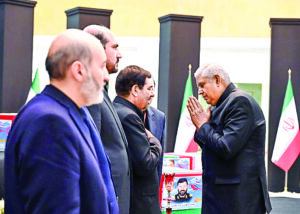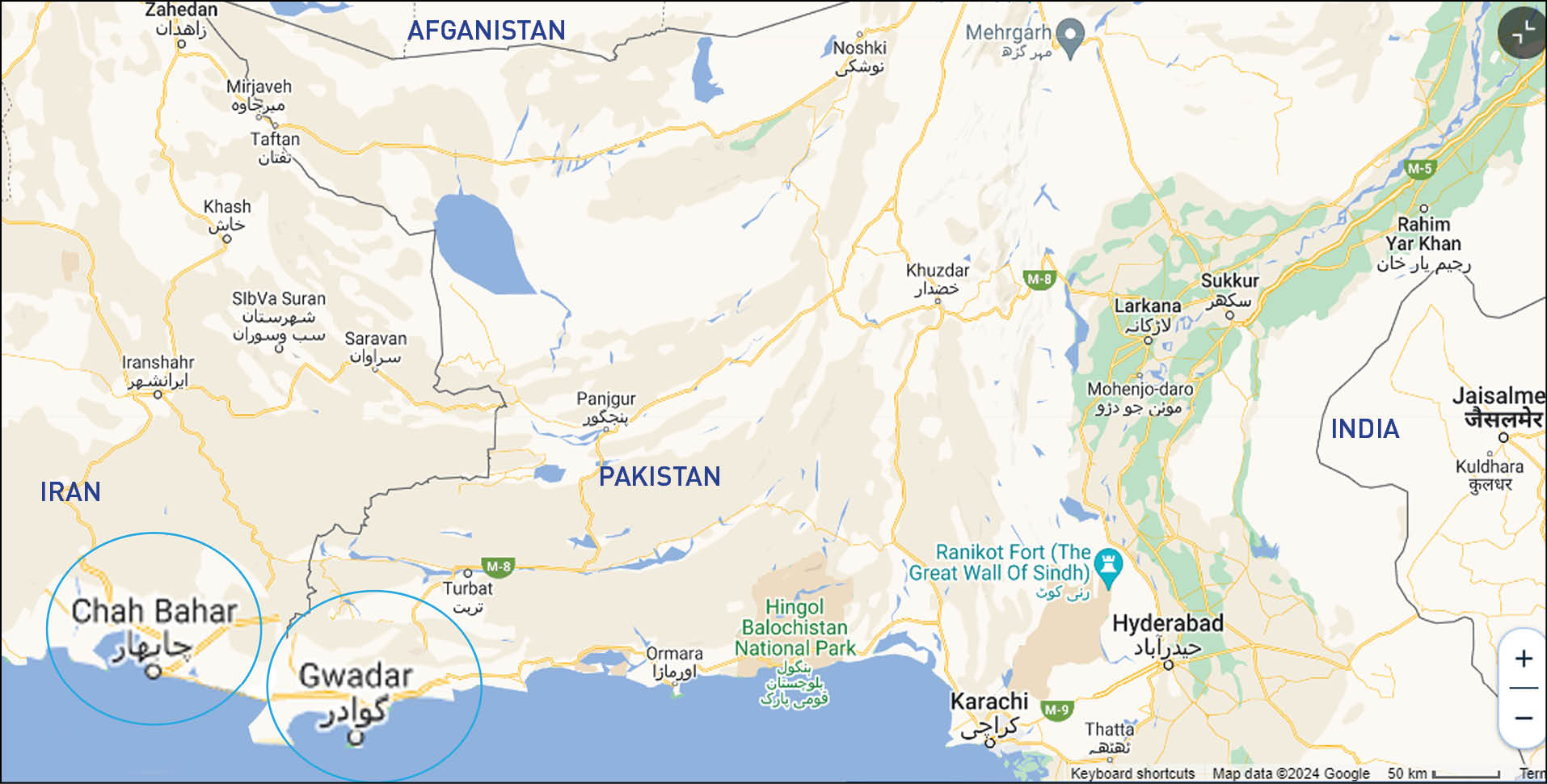NEW DELHI: The US will have to understand that if India gives up Chabahar port, it is up for grabs by China.
A major strategic and diplomatic event remained under the radar and didn’t get much traction in the media due to ongoing general elections in India—India’s signing of a 10-year pact with Iran to develop and operate the strategically important Iranian Chabahar port. The 13 May 2024 move was extra significant because since 2016 India was annually renewing the port operations contract with Iranian authorities.
India would be represented by India Ports Global Ltd. (IPGL), while the Ports and Maritime Organization of Iran would be the Iranian authority. India has pledged to invest around $120 million in equipment and machinery for the port and opened a credit line of $250 million for the project infrastructure. This takes the total Indian commitment to $370 million. Since 2016, India has committed about $500 million to the project.
Why is this move significant? Chabahar is seen as a gateway to landlocked Afghanistan and energy-rich Central Asia. In one stroke Chabahar project nullifies the importance of the problem-ridden Chinese-controlled Gwadar Port project and China Pakistan Economic Corridor (CPEC) in Pakistan.
INTERNATIONAL NORTH-SOUTH TRANSPORT CORRIDOR
Another India-backed project, the International North-South Transport Corridor (INSTC) was conceived in 2000 and ratified by India, Iran, and Russia in 2002. Though another 10 countries—Azerbaijan, Armenia, Belarus, Kazakhstan, Kyrgyzstan, Oman, Syria, Tajikistan, Turkey, and Ukraine—signed up for the project, only arch-rivals Armenia and Azerbaijan have shown significant interest.
In March 2023, while speaking at the Shanghai Cooperation Organisation (SCO) in Delhi, India’s National Security Advisor (NSA) Ajit Doval expressed India’s interest in including Chabahar port in the framework of the INSTC. Chabahar has a deeper harbour and is closer to India compared to Bandar Abbas, the original INSTC port in Iran.
Once connected with the 7,200 km long INSTC, Chabahar’s importance could increase manifold. As of today, INSTC passes from Mumbai to Iran’s Bandar Abbas by sea, Tehran to Bandar Anzali by rail, then either by rail via Azerbaijan or by sea onto Russia’s Astrakhan and onwards to St. Petersburg. However, the involvement of Azerbaijan, which has created an anti-India grouping with Turkey and Pakistan; and raises the Kashmir issue at regular intervals, may force India to take either the Caspian Sea route or involve Armenia.
As per the studies and trials conducted by the Ministry of Commerce and Industry in 2014 and 2020, INSTC would save 40% time and 30% cost compared to the Suez Canal route. The original idea was to connect to Western Europe using INSTC via Russia, however, the Russia-Ukraine war has dimmed the chances of that prospect.
Keeping in mind the Western reluctance to use the proposed INSTC, Armenia jumped into the fray and proposed an alternate route—Mumbai, Chabahar, Armenia, Georgia, Black Sea, Bulgaria route as a Western Europe corridor. However, the involvement of Iran may keep the Western nations away from this corridor too. That may be the reason, India proposed and started working on India, Middle East, Europe Economic Corridor (IMEC) along with Saudi Arabia, the European Union, the United Arab Emirates (UAE), France, Germany, Italy, and the United States.
CHINESE HEGEMONY
China has positioned itself as a self-proclaimed leader of the Global South. This disease has further worsened with the growing competition with the United States. This led to the “my way or highway” approach resulting in many disputes with many Asian and European powers, especially with India.
China’s 2014 project Trans-Caspian International Transport Route (TITR)—colloquially known as the “Middle Corridor,” runs from China through Kazakhstan, across the Caspian Sea to Azerbaijan and Georgia, and then to Europe via Turkey or the Black Sea. China sees INSTC and any such project as a direct threat to its Belt and Road Initiative (BRI). China’s worldwide BRI investment has zoomed past the $1 trillion mark with about $634 billion in construction contracts and $419 billion in non-financial investments. Not many returns accruing from BRI are frustrating the Chinese leadership.
Another thrust area of China is the Suez Canal. Until now the Chinese companies have pledged over $3 billion in the Suez Canal Economic Zone (SCZONE). In 2024 alone China has invested $894 million
In 2019, Chinese President for Life, Xi Jinping asked senior members of the Communist Party to be ready for “black swan” and “grey rhino” events. A “black swan” is an unpredictable market event with extreme financial consequences, while a “grey rhino” is a large, visible threat that goes ignored. Soon thereafter China unleashed Covid-19 on the world, decimating economies and countries. Such dangerous moves demonstrate China’s mindset and urgency for world hegemony.
Therefore, China would go to any lengths to sabotage any project that threatens its investments. Be it INSTC or IMEC. I and many experts believe that the chaos in Eastern Europe and the Middle East has a secondary aim of that grand strategy. If the primary aim is to get Western powers entangled in unnecessary wars then stalling projects like INSTC and IMEC would be the secondary aim. Unfortunately, up to an extent, the indecisiveness and vested interests in the West are making China win this race.

THE U.S. THREAT OF SANCTIONS
The United States has to understand that sanctions have limited effect. Sanctions on strategic partners like India are even a bigger dampener and push the friendly nation away from the US. For decades, the Damocles sword of sanctions has kept Indian companies and banks away from the Chabahar port, depriving it of achieving its full potential. Eventually, India is breaking those shackles.
The US administration knows very well that India is the only country that can take on China in all of the Indo-Pacific, but India would do that on its terms. The American blinkers-on strategy on China, deprive them of the bigger picture. They have to understand that if India gives up Chabahar port, it is up for grabs by China. Despite being a close ally of China, Iran is not foolish. It doesn’t want to put all its eggs in one basket. And India presents them with that opportunity.
Being friendly with Iran and Russia also gives India access to understanding what is happening in those countries. Cutting off the flow of that information and pushing Iran fully into the Chinese camp would not be a wise move by the US. They have already committed that blunder in the Russian case.
INDIA ON THE RIGHT PATH
As per the World Economic Forum, India could be the world’s third-largest economy anytime between 2027and 2029. A Bloomberg study reveals that India could become the world’s number-one GDP contributor as early as 2028, overtaking China. India would also be the world’s leading skilled and disciplined manpower supplier to the Western world.
Therefore, projects like Chabahar port, INSTC, and IMEC are very important to the Indian economy and the world. The West must facilitate India achieving those aims for their own sake. Support or no support, either way, India is destined to grow and achieve the status of a responsible power. It is better to be part of that growth story rather than be with the naysayers.
Cdr Dhawan served in the Indian Navy from 1988 to 2009. He was a Maritime Reconnaissance Pilot and a Flying Instructor. He is a geopolitical analyst and writes for various websites and organizations.

